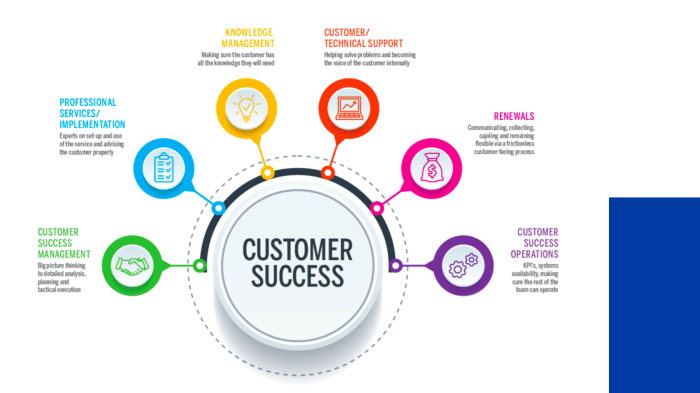Customer Success Tips, let’s dive into the world of creating loyal customers and sustainable growth. From the importance of customer success to effective management strategies, this guide has it all.
Learn how successful companies excel in customer retention and discover the tools and technologies that can take your business to the next level.
Importance of Customer Success
Customer success is essential for businesses to thrive in today’s competitive market. It involves ensuring that customers achieve their desired outcomes while using the product or service, leading to increased satisfaction and loyalty.
Examples of Companies Excelling in Customer Success
- Amazon: Known for its exceptional customer service and personalized recommendations, Amazon has set the standard for customer success.
- Zappos: This online shoe retailer is renowned for going above and beyond to satisfy customers, leading to high levels of loyalty and repeat business.
Impact of Customer Success on Customer Retention and Loyalty
Customer success plays a crucial role in customer retention and loyalty. By ensuring that customers are getting value from the product or service, businesses can increase customer satisfaction, reduce churn, and foster long-term relationships.
How Customer Success Contributes to Long-Term Business Growth
- Repeat Business: Satisfied customers are more likely to make repeat purchases and recommend the product or service to others, leading to organic growth.
- Brand Advocacy: Customers who have successful experiences are more likely to become brand advocates, promoting the business through word-of-mouth and social media.
Strategies for Building Customer Success
When it comes to building customer success, having a solid strategy in place is crucial. This involves creating a plan that focuses on meeting the needs and expectations of your customers, ultimately leading to long-term relationships and loyalty. Here are some tips to help you develop an effective customer success strategy.
Role of Personalized Communication
Personalized communication plays a key role in customer success. By tailoring your interactions with customers based on their individual preferences, behaviors, and feedback, you can build stronger relationships and enhance customer satisfaction. This can involve using customer data to personalize emails, messages, and recommendations, as well as providing proactive support and guidance.
Examples of Successful Customer Success Programs
One example of a successful customer success program is the use of customer success managers who work closely with clients to ensure they are getting the most out of the product or service. These managers serve as a dedicated point of contact for customers, helping them navigate challenges, optimize their usage, and achieve their goals. Another example is the implementation of customer training and onboarding programs to educate users and set them up for success from the start.
Aligning Customer Success Goals with Business Objectives
To align customer success goals with overall business objectives, it’s important to ensure that your customer success strategy is in line with the company’s mission, values, and key performance indicators. This involves setting clear and measurable goals for customer success that directly contribute to the organization’s growth, profitability, and sustainability. By linking customer success outcomes to business outcomes, you can demonstrate the value of investing in customer relationships and drive success for both your customers and your business.
Best Practices in Customer Success Management

Effective customer success management is crucial for retaining customers and fostering long-term relationships. By focusing on key elements such as continuous feedback, measuring success metrics, and optimizing onboarding processes, businesses can ensure customer satisfaction and loyalty.
Importance of Continuous Customer Feedback
Continuous customer feedback plays a vital role in improving customer success. By actively listening to customer needs and concerns, businesses can make necessary adjustments to their products or services, ultimately enhancing customer satisfaction and loyalty.
- Regularly solicit feedback through surveys, interviews, and customer support interactions.
- Use feedback to identify areas for improvement and prioritize customer-centric initiatives.
- Implement feedback-driven changes to enhance the overall customer experience.
Measuring and Tracking Customer Success Metrics
Measuring and tracking customer success metrics is essential for evaluating the effectiveness of customer success strategies. By analyzing key performance indicators, businesses can identify areas of strength and weakness, allowing for informed decision-making and continuous improvement.
- Define clear and measurable customer success goals and objectives.
- Utilize customer success platforms to track key metrics such as customer satisfaction, retention rates, and upsell opportunities.
- Analyze data regularly to identify trends, patterns, and areas for optimization.
Optimizing Customer Onboarding Processes for Success
Effective customer onboarding is critical for setting the foundation of a successful customer relationship. By streamlining the onboarding process and providing adequate support and guidance, businesses can ensure a positive customer experience from the start.
- Develop a structured onboarding program that educates customers on product features and benefits.
- Provide personalized onboarding assistance to address individual customer needs and preferences.
- Continuously iterate on the onboarding process based on feedback and performance metrics to enhance customer success.
Tools and Technologies for Customer Success: Customer Success Tips

In today’s digital age, having the right tools and technologies is essential for effectively managing customer success. These tools can streamline processes, enhance communication, and provide valuable insights to ensure customer satisfaction and retention.
Essential Tools for Managing Customer Success Effectively
- Customer Relationship Management (CRM) software: Helps track customer interactions, manage accounts, and monitor customer health.
- Customer Success Platforms: Offer a centralized hub for customer data, communication tools, and analytics to drive proactive customer success strategies.
- Feedback and Survey Tools: Enable gathering feedback from customers to identify areas for improvement and measure customer satisfaction.
- Knowledge Base and Self-Service Portals: Provide customers with resources and information to solve issues independently.
Comparison of Different Customer Success Platforms
- Gainsight: Known for its comprehensive customer success solutions, including customer health monitoring and task automation.
- Totango: Focuses on customer engagement and retention through analytics and personalized customer journeys.
- ClientSuccess: Offers a user-friendly platform with features like customer health scores and automated workflows.
Automation in Enhancing Customer Success Operations, Customer Success Tips
Automation plays a crucial role in customer success by streamlining routine tasks, sending personalized communications, and triggering alerts for proactive actions. By automating repetitive processes, customer success teams can focus on building stronger relationships and driving value for customers.
Role of Data Analytics in Improving Customer Success Outcomes
Data analytics empowers customer success teams to make informed decisions based on customer behavior, preferences, and trends. By analyzing data points such as customer interactions, product usage, and feedback, organizations can identify patterns, predict customer needs, and optimize their customer success strategies for better outcomes.
